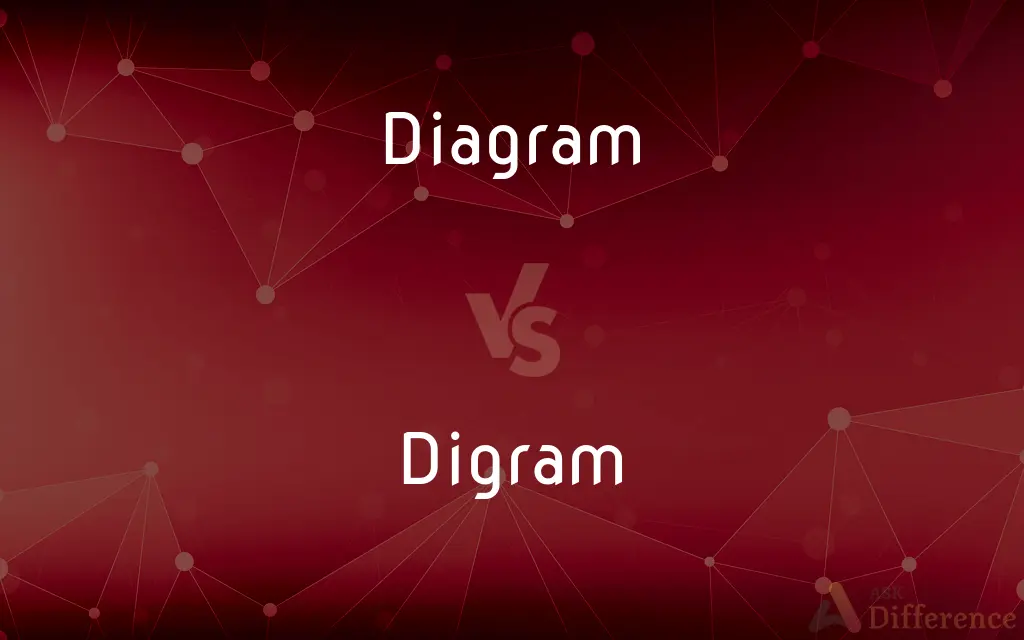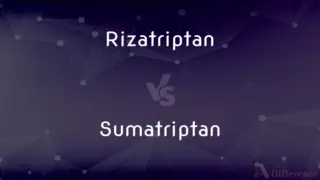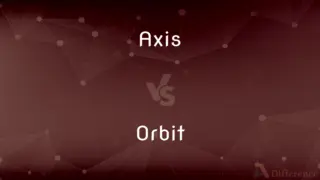Diagram vs. Digram — What's the Difference?
By Maham Liaqat & Fiza Rafique — Updated on May 4, 2024
A diagram is a visual representation that maps out or illustrates a concept or process, often used to simplify complex information. A digram, on the other hand, refers to a pair of letters used or analyzed together in linguistics or cryptography.

Difference Between Diagram and Digram
Table of Contents
ADVERTISEMENT
Key Differences
A diagram is used in a wide range of fields including science, engineering, and education to visually communicate information, relationships, and processes. It helps in understanding complex data through illustrations like flowcharts, schematics, and blueprints. Whereas a digram is a specific term used primarily in linguistic and cryptographic contexts, referring to a sequence of two adjacent characters, typically letters.
Diagrams can be categorized into various types such as flowcharts, which show processes, or organizational charts that depict structures within an organization. On the other hand, digrams are analyzed to study phonetic combinations in languages or to solve ciphers in cryptography.
In creating a diagram, visual elements like lines, symbols, and texts are used to enhance comprehension and presentation. In contrast, digrams are studied as textual elements, where the frequency and arrangement of letter pairs are examined for patterns and statistical analysis.
Diagrams are integral in teaching methodologies to clarify and visually present information, facilitating easier learning and retention. Digrams, however, are mostly utilized in specialized studies such as linguistics for phonetic analysis or in cryptography for code-breaking techniques.
While diagrams are universally understood and used tools in visual communication across various disciplines, digrams serve a niche purpose, primarily beneficial in fields requiring textual analysis.
ADVERTISEMENT
Comparison Chart
Definition
A graphical representation of information or processes.
A pair of letters or characters analyzed together.
Usage
Broadly used in many fields to simplify and illustrate complex information.
Used in linguistics and cryptography.
Types
Flowcharts, organizational charts, mind maps, etc.
No types, but varies based on language or encryption method.
Function
Helps in visual learning, understanding complex systems, and problem-solving.
Analyzes letter frequency and patterns for linguistic or cryptographic purposes.
User Audience
Students, professionals, educators, general public.
Linguists, cryptographers, researchers.
Compare with Definitions
Diagram
A simplified drawing showing the appearance, structure, or workings of something.
The engineer created a diagram of the new circuit.
Digram
A pair of letters, especially used to analyze the structure of languages.
The linguist used digrams to study the frequency of letter combinations in English.
Diagram
A symbolic representation of information according to some visualization technique.
The presentation included a diagram that outlined the company’s growth strategy.
Digram
A linguistic term referring to two consecutive letters in a script.
Understanding digrams is essential for phonetic analyses in linguistics.
Diagram
A graphic design that explains rather than represents.
His lecture was aided by several diagrams showing data flow.
Digram
Two adjacent characters in a text considered together for cryptographic analysis.
Decrypting the message required analyzing the digrams for pattern inconsistencies.
Diagram
Any drawing that illustrates or visually explains a topic.
The textbook featured diagrams to explain the photosynthesis process.
Digram
A textual pair used in statistical analysis of text.
His thesis included a section on the significance of digrams in encrypted communications.
Diagram
A chart or plan that makes something less complicated and easier to understand.
She used a complex diagram to explain the legal process.
Digram
A component of a cipher used in breaking codes based on letter pair frequency.
The cryptographer noted the recurring digrams which helped crack the encryption.
Diagram
A diagram is a symbolic representation of information using visualization techniques. Diagrams have been used since ancient times on walls of caves, but became more prevalent during the Enlightenment.
Digram
A digraph.
Diagram
A simplified drawing showing the appearance, structure, or workings of something; a schematic representation
A diagram of the living room
Digram
A digraph.
Diagram
Represent (something) in graphic form
The experiment is diagrammed on page fourteen
Diagram
A plan, sketch, drawing, or outline designed to demonstrate or explain how something works or to clarify the relationship between the parts of a whole.
Diagram
(Mathematics) A graphic representation of an algebraic or geometric relationship.
Diagram
A chart or graph.
Diagram
To indicate or represent by or as if by a diagram.
Diagram
A plan, drawing, sketch or outline to show how something works, or show the relationships between the parts of a whole.
Electrical diagrams show device interconnections.
Diagram
A graph or chart.
Diagram
(category theory) A functor from an index category to another category. The objects and morphisms of the index category need not have any internal substance, but rather merely outline the connective structure of at least some part of the diagram's codomain. If the index category is J and the codomain is C, then the diagram is said to be "of type J in C".
Diagram
(transitive) To represent or indicate something using a diagram.
Diagram
(UK) To schedule the operations of a locomotive or train according to a diagram.
Diagram
A figure or drawing made to illustrate a statement, or facilitate a demonstration; a plan.
Diagram
Any simple drawing made for mathematical or scientific purposes, or to assist a verbal explanation which refers to it; a mechanical drawing, as distinguished from an artistical one.
Diagram
To put into the form of a diagram.
Diagram
A drawing intended to explain how something works; a drawing showing the relation between the parts
Diagram
Make a schematic or technical drawing of that shows how things work or how they are constructed
Common Curiosities
Can diagrams include text?
Yes, diagrams often include text to label and further clarify the visual elements.
Why might a linguist be interested in digrams?
Linguists study digrams to understand and analyze phonetics, orthography, and structure of languages.
What is the main difference between a diagram and a digram?
A diagram is a visual representation used for explaining concepts, while a digram is a sequence of two adjacent letters analyzed in linguistic or cryptographic contexts.
How do digrams help in cryptography?
Digrams are analyzed to detect patterns and frequencies that can assist in deciphering codes and ciphers.
Are there specific rules for interpreting digrams in linguistics?
While there are no strict rules, understanding the frequency and distribution of digrams can provide insights into phonetic patterns and language structure.
What are some common tools used to create diagrams?
Common tools include graphic design software like Adobe Illustrator, diagramming tools like Microsoft Visio, or even simple drawing tools in presentation software like Microsoft PowerPoint.
What are some challenges in working with digrams?
Challenges include the need for comprehensive data for analysis and the complexity of cipher patterns in cryptography.
Are digrams used outside of linguistics or cryptography?
Digrams are primarily used within these fields, though they may occasionally be referenced in other contexts involving textual analysis.
Why are diagrams important in education?
Diagrams help simplify and visually communicate complex information, making it easier to understand and remember.
How can digrams be misleading in cryptography?
Over-reliance on digram frequency without considering context or other encryption techniques can lead to incorrect decryption outcomes.
What skills are needed to create diagrams?
Skills in visual design, understanding of the information being depicted, and ability to abstract and simplify complex data are crucial.
Can anyone create a diagram?
Yes, anyone can create a diagram with basic knowledge of the concept and a tool to visualize it, though quality varies with expertise.
Is it easier to learn with diagrams?
Many people find visual learning through diagrams easier than textual learning, especially for complex subjects.
Can diagrams be used in business settings?
Absolutely, diagrams are extensively used in business for planning, process mapping, organizational structuring, and more.
How do diagrams facilitate problem-solving?
Diagrams provide a clear visualization of problems and processes, enabling easier identification of components and relationships necessary for solutions.
Share Your Discovery

Previous Comparison
Rizatriptan vs. Sumatriptan
Next Comparison
Axis vs. OrbitAuthor Spotlight
Written by
Maham LiaqatCo-written by
Fiza RafiqueFiza Rafique is a skilled content writer at AskDifference.com, where she meticulously refines and enhances written pieces. Drawing from her vast editorial expertise, Fiza ensures clarity, accuracy, and precision in every article. Passionate about language, she continually seeks to elevate the quality of content for readers worldwide.
















































